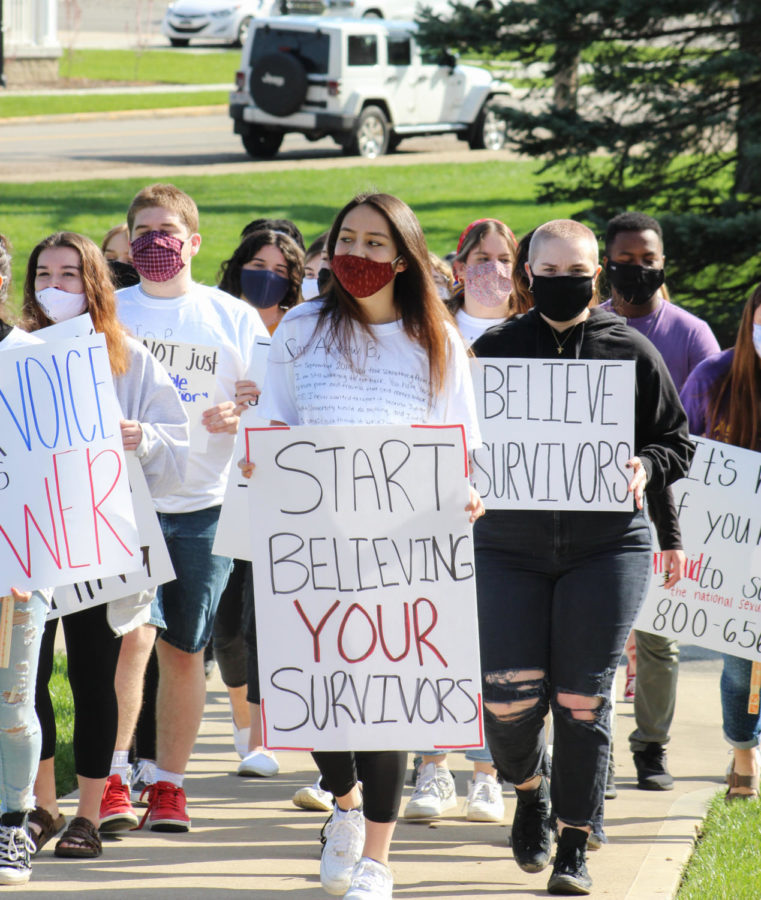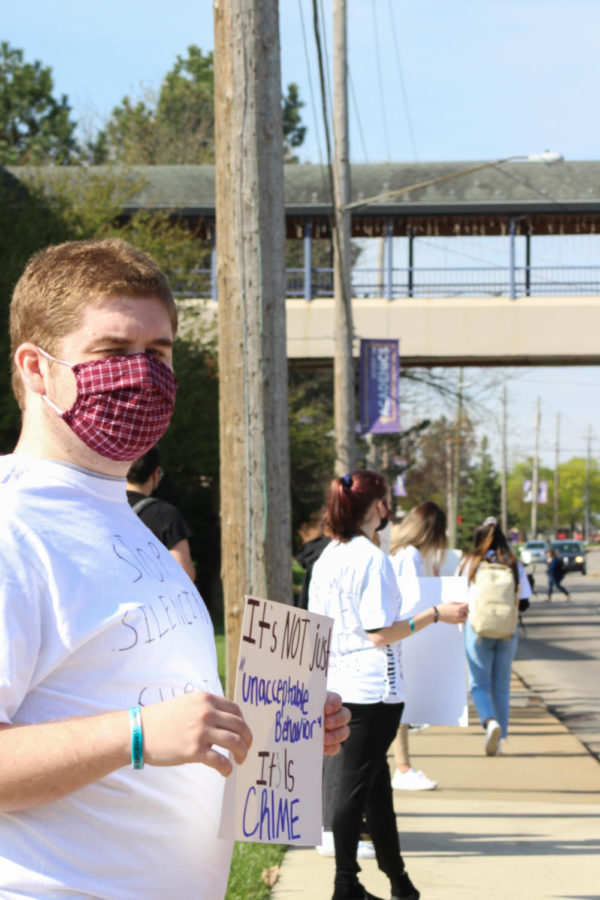Students elevate voices in recognition of Sexual Assault Awareness Month
Reina Britt, founder of Elevate, leads protestors back to the fountain in front of the student center after walking past the Claremont Ave. intersection.
April 23, 2021
White shirts covered in red and black ink were hung on a clothesline in the Student Center on April 1, through a collaborative effort of Elevate and Safe Haven. Each shirt depicts a story of sexual assault through the eyes of a survivor or those of someone who lost a friend to violence.
Clothesline Project, the organization that started the trend, is aimed to bring awareness to the issue of sexual abuse or sexual assault through the use of a visual display. Safe Haven, a domestic violence shelter and rape crisis center in Ashland County, has held this event in years past, holding their last event on April 15 at Corner Park in Ashland.
Hannah Shaw, the campus advocate from Safe Haven, shared what the event entailed and what they expect will come out of it.
“The survivor speakout was originally just an idea that came from our sexual assault support group,” Shaw said. “They are very outspoken and want to shout from the rooftops why what happened to them is not okay. We’ve never done a speak out like this before for sexual assault.”
Survivors told their stories and shared words of support for other survivors.
The white shirts featured at AU’s campus, were also hung up at the speak-out event, after being returned to Safe Haven. Reina Britt, founder of Elevate, said that this is not the first time these shirts have been on display around the campus community.
“These shirts are written by not only students on this campus, but community members as well, and they [Safe Haven] have had this project going on for a while,” Britt said.
Students were able to freely express themselves through this display, while representing the millions of Americans who are sexually assaulted each year. According to RAINN, an American is affected by this kind of violence every 73 seconds.
Ashland University’s showcase of the project attracted the attention of a statewide media outlet, Cleveland 19 News, and thousands of individuals across the campus and community.
Juliet Touma, student at AU, participated in the Clothesline Project and found herself at the forefront of media attention after posting photos of the shirts and gaining over one-thousand ‘retweets’ on Twitter.
“My role came about suddenly,” Touma said. “On April 1, I tweeted some pictures of the Clothesline Project—I just thought that those shirts spoke to me and they pulled my heartstrings, so I tweeted them.”
She only expected to receive a couple of likes, but was quickly greeted with over 3,500 likes and more than one-thousand retweets. This sudden influx resulted in movements happening on campus discussing Title IX procedures and treatment of survivors everywhere.
“I’m using my platform on social media and as a senior student here to promote other stories and give them a platform,” Touma said. “I hope that the university takes this seriously and sees that the Title IX policy has to change. Whether [that change is] providing more counselors, or having advocates in the Title IX process from the get-go, there’s a lot that can be changed and a lot that we can do to make survivors feel more comfortable on this campus.”
Not long after the shirts went up, a few came down.
Two shirts had to be pulled from display by AU administration after concern of the identities of students or faculty were released, causing a fear for safety.
“The ‘faculty shirt’ and the ‘university president shirt’ that were both taken down were hung up at Ashland in the past,” Britt said. “Safe Haven has had them since at least 2017.”
Dr. Robert Pool, vice president for student affairs and Title IX coordinator, commented on the reasoning for several shirts being taken down and the cause for the university’s statement on the Clothesline Project.
“Three shirts that were authorized to come down included either names, first name/last name, first name/initial, or a title that only is only ascribed to one person at this university,” Pool said, “They were personal, identifiable information. The majority of the 50 plus shirts all stayed.”
A fourth shirt, however, came down without being authorized.
The shirt, which read, “Me: Reports RAPE to University, Faculty Member: Did you LIKE IT?,” came down unnecessarily after an unnamed staff person “took it upon themselves to take it down.”
The administration was made aware and told the organizers that it can go back up.
Several students came forward at the Student Senate meeting on April 6, calling out the university for silencing survivors and taking the side of assaulters through unjust hearings and the removal of certain shirts.
These shirts were part of a long-time project, Britt said in a public Student Senate meeting, “We don’t know when these shirts were written or if they came from Ashland because this is a community-wide project.”
Britt used the platform of the Senate meeting, while dressed in the outfit she was assaulted in, to call out for changes to be made to Title IX and the treatment of survivors.
Once the university is made aware of an assault on campus, students are given the option to be referred to the university’s Title IX policy, or to approach the police with a formal investigation.
“Students are not required to speak with the Title IX coordinator once a report is known,” Pool said. “In my initial invitation to meet, I make it clear that meeting with the Title IX coordinator is not required, but strongly encouraged. I also include information about all available supports (confidential, Dept. Coordinators, counselors, etc.). It is up to them if and when to meet, or not, and in what manner (with a support person, via Zoom, in person, or telephone).”
As deputy coordinators and Title IX coordinators, Pool said that they remain neutral to allow the due process to fetter out facts and present them so the board can determine if there was a violation or not.
“For Title IX, our culture on our campus must be that we will not tolerate sexual assault and sexual misconduct of anyone,” Pool said. “In order for people to know how to respond and that they can respond with confidence that their cases are going to be held in trust is to build this process that students are trained on who to go to, how to go and what they will expect on both sides. We train our staff to know that when cases come forward, you believe them—what I mean by that is that you don’t automatically question the content that’s coming in reports.”
A Survivor’s Story
Former AU student Makenna Fisher’s story took place on Labor Day weekend, just off-campus at the football house.
She was called by a drunk friend who needed someone to escort her back to her dorm. Fisher, a student dispatcher for Safety Services at the time, had a shift coming up, but set off to help her friend.
“I was searching through the house and that’s where I was pulled into a dark room and I was sexually assaulted by three men,” Fisher said. “I was in shock. I wanted to guard myself from the feelings I was feeling, and I still think to this day that I’m in shock because I still have yet to process those feelings.”
Fisher admitted that she felt scared at the Title IX meeting because of all the attention that could be drawn to her if she requested there be a formal investigation. She dismissed the investigation, and instead, opted to seek counseling.
“When I went upstairs to the counseling department, they told me it was going to be a four to six week wait for me to see a counselor.”
The three counselors on AU’s campus had a long line of students, and after being offered the opportunity to skip to the front, Fisher felt she had no right to stand between other students’ needs.
Fisher said that her counselor did not let her relive her experience, which did not alleviate her pain. She wanted to be heard, but instead she felt silenced.
“I’ve been to three or four different counsellors within a 60 miles radius of my town and none of them have really been able to help me bring my feelings to the surface,” Fisher said. ”I started feeling unsafe on campus and I was starting to feel very conscious of my surroundings and thinking, ‘is this guy next to me the person that raped me?’ Was the group of three guys at the eating hall staring at me the ones who raped me?’”
Fisher did not get to find her resolution on campus, but instead found solace in separating herself from the area that her assault took place.
“I wish that they [AU] had someone on that board who was a female, who could relate to whatever I was feeling.”
After all of that, Fisher dropped out of school. She continues to comment on AU’s posts and monitor the school’s responses to cases like hers.
The goal that Pool and other administration members hope to achieve is resolution in cases.
“Sometimes that resolution is going through with a formal investigation all with due process, sometimes it’s just getting the students’ support they’re asking for and leaving the door wide open for future resolution,” Pool said. “But in all cases, we try to let that student be in control.”
President of AU Dr. Carlos Campo, commented that the response from students, alum and other community members was overwhelming.
“That tells me there is a lot of pent up hurt, anger and frustration around this issue,” Campo said. “One of the things I want to say is that I openly apologize for any culpability that the institution has for fostering that, because we want to say that we can’t begin to comprehend the fullness of the pain that so many people are in, but we are not just going to say it at that and leave it at that. It was a wake up for me to say that what’s real is that people are upset, people are hurting and feeling frustrated.”
Britt spoke up about being reached out to by graduated students who felt the impact of the project and the protest.
“This entire movement going on has just shown how many survivors are actually on this campus and how far they stretch back,” Bitt said. “There’s alumni reaching out to me from campus in 2019 with their stories, and about how Ashland has failed them in this. It’s important to realize how Ashland can take Title IX laws and how they can implement them in a better way that’s more survivor-friendly that isn’t going to victim-blame and take the side of the assaulter.”
The purpose for the protest being held on campus is to be vocal about stories that many survivors have.
“We wanted to hold it on Ashland’s campus to make sure that they know how many lives they’ve affected and how many stories are out there of people that are too afraid to come forward because of Ashland and the perception of them,” she said.
Campo extended his desire for continuous improvement in areas that students believe to be lacking.
“Shame on us if we don’t respond to that. We want to be better and our response could have been better,” he said. “It’s hard because there’s a legal side—you want to protect students, but there’s only so much you can say, and so our response could have been better in general. We want to continue to seek improvement.”




